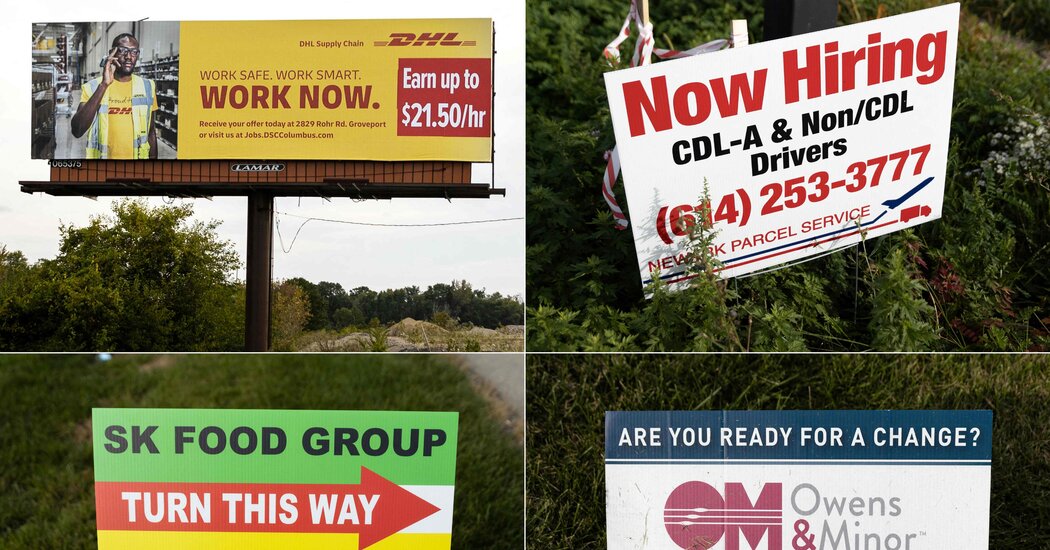
Everything in the November jobs numbers Friday was good except for the number that usually gets the most attention.
The 210,000 jobs that U.S. employers added last month was far below analyst expectations. But most of the other evidence in the report points to a job market that is humming. An open question a few months ago — is this a tight labor market or a loose one? — is quickly being settled in favor of “tight.”
Most notably, the jobless rate fell to 4.2 percent from 4.6 percent, a remarkable swing in a single month. The speed with which unemployment has gone from a grave crisis to a benign situation is astounding. Unemployment was 6.7 percent last December. In one year, we’ve experienced an improvement that took three and a half years in the last economic cycle (March 2014 to September 2017).
Sometimes a falling unemployment rate is driven by a pernicious trend: People drop out of the labor force. The opposite was true in November. The survey of American households on which the data is based showed uniformly positive signs. The number of people working was up by 1.1 million while the number of adults not in the labor force — neither working nor looking for work — fell by 473,000.
Among people in their prime working years, those 25 to 54, the share of people employed rose by a whopping half a percentage point. It was 78.8 percent in November, rapidly approaching its pre-Covid level of 80.4 percent. By early in 2022, it’s easy to imagine that people in that age bracket will be employed at prepandemic rates.
Even the disappointing number on job creation, derived from a separate survey of employers, has some silver linings. For one, it was accompanied by positive revisions to September and October job growth numbers, amounting to a combined 82,000, which takes some of the sting away. Revisions have been uncommonly large, and mostly in a positive direction, in recent months, reflecting challenges collecting data in a pandemic economy.
For another, soft job creation numbers may also be evidence of a tight labor market. Employers may want to add jobs in larger numbers, but are constrained by the number of workers they’re able to find. That story is certainly consistent with many business surveys and anecdotes about labor shortage issues.
A tight job market — one in which workers are scarce and employers have to compete to attract workers — is generally the goal of economic policy. Compensation tends to rise, and workers are confident in their ability to find a new job. The new numbers are just the latest evidence that this is the world American workers are living in right now. (Among the other evidence: The rate of people voluntarily quitting their jobs is at record levels.)
That’s not to say everything is perfect. The share of adults in the labor force remains significantly below prepandemic levels — 61.8 percent in November, compared with 63.3 percent in February 2020. That reflects in part the decisions of people to retire early. And it remains unclear how many of those people might return to work as the economy and public health conditions improve.
But in terms of policy, this increasingly looks like an economy on the right track. The work of macroeconomic stabilization appears to be pretty much complete. At its coming policy meeting, the Federal Reserve will seriously consider winding down its program of bond-buying faster than planned, Chair Jerome Powell said this week.
Despite the soft job creation numbers, the overall November employment report appears to support those plans. Fed officials would like to see a stronger rebound in labor force participation, but that measure was at least heading in the right direction in November. And ultimately it isn’t Fed policy that will decide whether, for example, a 62-year-old who left his job during the pandemic decides to start working again.
If anything, the new numbers support the idea that the Fed has found itself out of position, with a monetary policy that is looser than it should be at a time when the labor market is quite healthy and with inflation far above its target.
Consider this: In the last economic cycle, the Fed began tapering its bond purchases in December 2013, when the unemployment rate was 6.7 percent and inflation was coming in below the Fed’s 2 percent goal. This time, it began when the jobless rate was 4.2 percent and inflation was in the ballpark of 6 percent (November inflation numbers have not yet been released).
Even if you believe the Fed was too quick to tighten monetary policy in 2013 — and the sluggish recovery of the 2010s is evidence that it was — the contrast is striking. In that sense, a more aggressive tapering plan from the Fed will be an effort to adjust its policy stance with the facts on the ground without causing too much disruption to markets or the economy.
If the Fed succeeds, the economy will keep growing steadily and the labor market will continue its gradual improvement. But it’s worth noting just how rapid the improvement has already been. In February, the Congressional Budget Office was forecasting the unemployment rate would be 5.3 percent in the current quarter. It has ended up a full percentage point below that level.
Ultimately, this has been a speedy labor market recovery, and one that appears to have more room to run. Policymakers have every reason to take the win and continue adjusting to that reality.



